
© Lemon squeezer
After our test of the new Redmi Note 13 4G, the entry-level proposition for less than 200 euros from Xiaomi, here is now our review of the Xiaomi Redmi Note 13 Pro Plus. Behind this long name lies the highest mid-range proposition from the Chinese manufacturer. Although it is probably not the best smartphone in its category, the fact remains that this Pro Plus has arguments to put forward against the competition.
Price and availability
The Xiaomi Redmi Note 13 Pro Plus is available now for 469.90 euros in 8 GB of RAM and 256 GB of storage version. The version with 12 GB of RAM and 512 GB of storage used in this test costs 499.90 euros. All versions are available in black, white or purple.
Technical characteristics of the Xiaomi Redmi Note 13 Pro Plus
| Redmi Note 13 | Redmi Note 13 5G | Redmi Note 13 Pro | Redmi Note 13 Pro 5G | Redmi Note 13 Pro+ 5G | |
|---|---|---|---|---|---|
| Dimensions | 161.11 x 74 .95 x 7.6 mm | 161.1 x 74.95 x 7.98 mm | 159.9 x 76.7 x 8.3 mm | 161.4 x 74.2 x 8.9 mm | |
| Weight | 188.5 g | 174.5 g | 188 g | 221 g | 204.8 g |
| Screen | – 6.67'' – AMOLED screen – FHD+ (2400×1080) – 20:9 – 500 nits (typ), 1200 nits (HBM) – DCI-P3 – Corning® Gorilla® Glass 3 |
– 6.67'' – AMOLED screen – FHD+ (2400×1080) – 20:9 – 500 nits (typ), 1200 nits (HBM) – DCI-P3 – Corning® Gorilla® Glass 3 |
– 6.67'' – AMOLED screen – FHD+ (2400×1080) – 20:9 – 500 nits (typ), 1200 nits (HBM) – DCI-P3 – Corning® Gorilla® Glass 5 |
– 6.67''< br /> – AMOLED screen – 2712×1220 px – 20:9 – 500 nits (typ), 1200 nits (HBM ) – DCI-P3 – Corning® Gorilla® Victus™ |
– 6.67'' – Curved AMOLED screen – 2712×1220 px – 20:9 – 500 nits (typ), 1200 nits (HBM) – DCI-P3 – Corning® Gorilla® Victus™ |
| Refresh rate | – 120Hz AdaptiveSync – Touch sampling: up to 240Hz |
– 120Hz AdaptiveSync – Touch sampling: up to 240Hz |
– 120Hz AdaptiveSync – Touch sampling: up to 240Hz |
– 120Hz AdaptiveSync – Touch sampling: up to 240Hz |
– 120Hz AdaptiveSync< br /> – Touch sampling: up to 240Hz |
| Qualcomm Snapdragon® 685 | MediaTek Dimensity 6080 | MediaTek Helio G99 Ultra | MediaTek Dimensity 7200 | ||
| RAM/Storage Options | – 6/128 GB – 8/256 GB – UFS 3.1 storage |
– 8/256 GB – UFS 3.1 Storage |
– 8/256 GB – 12/512 GB – UFS 2.2 Storage |
– 8/256 GB – Storage UFS 3.1 |
– 8/256 GB – 12/512 GB – UFS Storage 3.1 |
| System version | MIUI 14 based on Android 13 | MIUI 14 based on Android 13 | MIUI 14 based on Android 13 | MIUI 14 based on Android 13 | MIUI 14 based on Android 13 |
| Main camera sensors | • 108MP main lens with AI: – 1/1.67'' sensor – Pixel of 0.64µm • Ultra wide angle lens of 8MP • Macro lens of 2MP |
• 108MP main lens with AI: – 1/1.67'' sensor – Pixel of 0.64µm • Ultra wide angle lens of 8MP • Macro lens of 2MP |
• 200MP main lens optical stabilizer (OIS) – 1/1.4'' sensor – 0.56µm pixel, Super Pixel 16 2.24µm-in-1 • 8MP ultra-wide-angle lens • 2MP |
• 200MP main lens optical stabilizer (OIS) – 1/1.4'' sensor – 0.56µm pixel, Super 16-in-1 2.24µm pixel • 8MP ultra-wide-angle lens • 2MP |
• 200MP main lens optical stabilizer (OIS) – 1/1.4'' sensor – 0.56µm pixel , 2.24µm 16-in-1 Super Pixel • 8MP Ultra Wide Angle Lens • 2MP |
| Selfie sensor | 16 Mp | 16 Mp | 16 Mp | 16 Mp | 16 Mp |
| Biometrics< /td> | – Under-screen fingerprint sensor – Facial unlock |
– Under-screen fingerprint sensor – Facial unlocking |
– Under-screen fingerprint sensor – Face unlock |
– Under-screen fingerprint sensor – Facial unlocking |
– Under-screen fingerprint sensor – Facial unlock |
| Other sensors | – NFC | – NFC | – NFC | – NFC | – NFC |
| Port | – USB Type C | – USB Type C | – USB Type C | – USB Type C | – USB Type C |
| – 5000 mAh | – 5000 mAh | – 5000 mAh | – 5100 mAh | – 5000 mAh | |
| Recharge | • Wired charging 33W • Charger included |
• 33W wired charging • Charger included |
• Wired Turbo Charge with included 67W charger • Full charge in 44 minutes |
• Wired HyperCharge with 120W charger included • Full charge in 19 minutes |
|
| Wireless networks | – 2G : GSM : B2/3/5/8 – 3G: WCDMA: B1/5/8 – 4G: LTE FDD ;: B1/3/5/7/8/20/28/38/40/41 – 4G: LTE TDD: B38/40/41 |
– GSM/CDMA/HSPA/EVDO/LTE/5G – Wi-Fi 802.11 a/b/g/n/ac/6, dual-band, hotspot – Bluetooth 5.3 |
– 2G: GSM: B2/3/5/8 – 3G: WCDMA: B1/5/8 – 4G: LTE FDD: B1/3/5/7/8/20/28 /38/40/41 – 4G: LTE TDD: B38/40/41 |
– 2G: GSM: B2/3/5/8 – 3G: WCDMA: B1/2/4/5/6/8/19 – 4G: LTE FDD: B1/2/3/4/5/7/8/12/13/17/18/19/20/26 / 28/32/66 – 4G : LTE TDD : B38/40/41 – 5G nbsp;: SA/NSA: n1/3/5/7/8/20/28/38/40/41/66/77/78 |
– 2G: GSM: B2/3/5/8 – 3G: WCDMA: B1/2/4/5/6/8/19 – 4G: LTE FDD: B1/2/3/4/5/7/8/12/13/17/18/19 /20/26/ 28/32/66 – 4G: LTE TDD: B38/40/41 – 5G: SA/NSA: n1/3/5/7/8/20/28/38/40/41/66/77/78 |
| Connectivity | • Bluetooth 5.1 • Wi-Fi 802.11a/b /g/n/ac (2.4GHz/5GHz) |
• Bluetooth 5.3 • Wi-Fi 5& ;nbsp;802.11a/b/g/n/ac (2.4GHz/5GHz) |
• Bluetooth 5.2 • Wi-Fi 5 802.11a/b/g/n/ac (2.4GHz/5GHz) |
• Bluetooth 5.2 • Wi-Fi 5 802.11a/b/g/n/ac (2.4GHz/5GHz) |
• Bluetooth 5.3 • Wi-Fi 6 802.11a/b/g/n/ac/ax (2.4GHz/5GHz) |
| SIM type | Nano SIM slot + Hybrid Nano SIM/microSD | Nano SIM slot + Hybrid Nano SIM/microSD | Nano SIM slot + Hybrid Nano SIM/microSD | Nano SIM + eSIM slot | |
| IP certification | IP 54 | IP 54 | IP 54 | IP 54 | IP 68 |
| Colors | Black, Blue, Green | Black, Blue, White | Black, Purple, Green | Black, Purple, Blue | Black, Purple, White |
A pleasant design and a screen worthy of high-end models
Available in black, white and purple, the Redmi Note 13 Pro Plus has some interesting design choices. On the back, we will find a camera module which is not very imposing due to its thickness, on a glass which stands out for its glossy appearance. On the rest of the ⅔ of the smartphone, Xiaomi has opted for a frosted glass effect which gives character to the whole.
While many manufacturers have chosen this year to return to flat designs, this Redmi Note 13 Pro Plus offers a symmetrical curved design at the front and back. the back of the smartphone, offering a pleasant grip and an aesthetically pleasing pebble appearance. In the middle is the matte aluminum frame with the most beautiful effect.
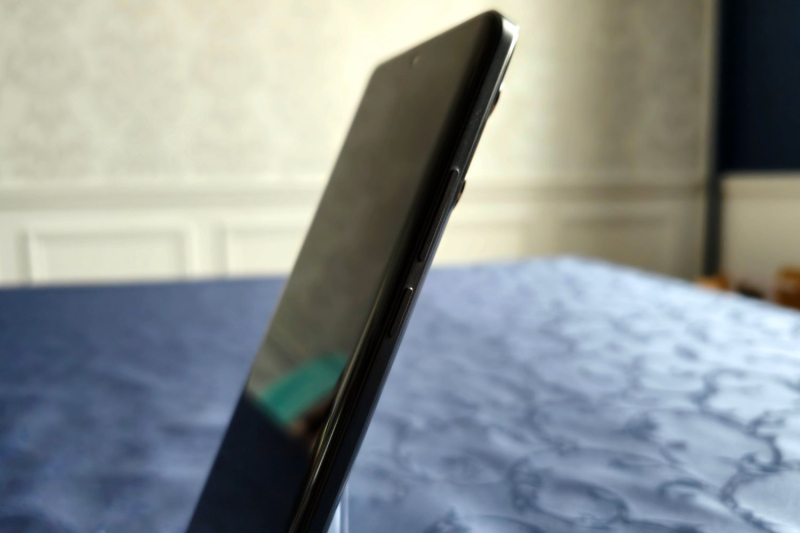
© Presse-citron
We will also appreciate the fact that Xiaomi has strengthened the design of the smartphone with < strong>shock-absorbing polymer seals, Gorilla Glass Victus and IP68 certification. This gives confidence in the resistance of the Redmi Note 13 Pro Plus, which also comes with a factory-installed screen protector, as well as silicone protection which is quite aesthetically pleasing, but which has the merit of being present in the box.
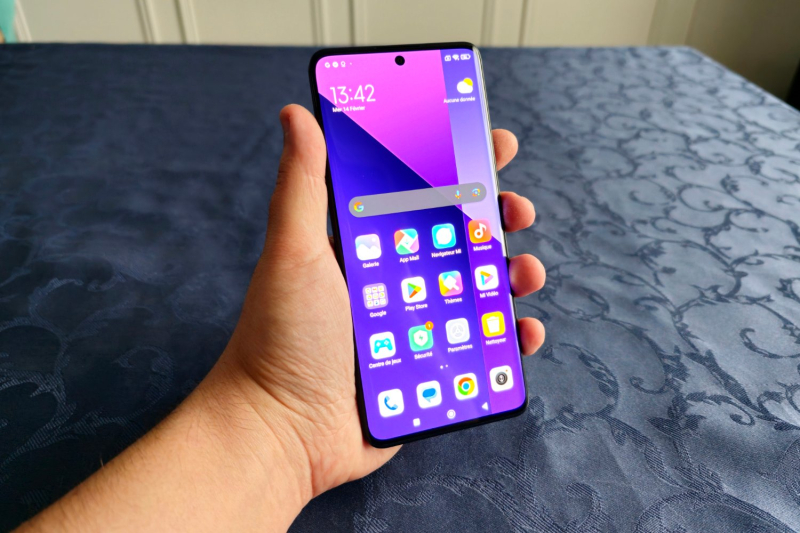
© Presse-citron
As for its display, the Redmi Note 13 Pro Plus features a 6.67-inch AMOLED display, offering a resolution of 2712 x 1220 pixels, with a refresh rate of 120Hz. This one shows less significant borders than the previous Note, with an excellent screen. The contained width of the smartphone makes it easy to use the curved screen, without causing accidental keystrokes.
Fastest charging speed, and good battery life
Speaking of what's in the box, we will emphasize the capital importance of the presence of the charger sold with the Redmi Note 13 Pro Plus. Indeed, the smartphone has absolutely exceptional charging capabilities that will make owners of the most high-end smartphones green with envy.
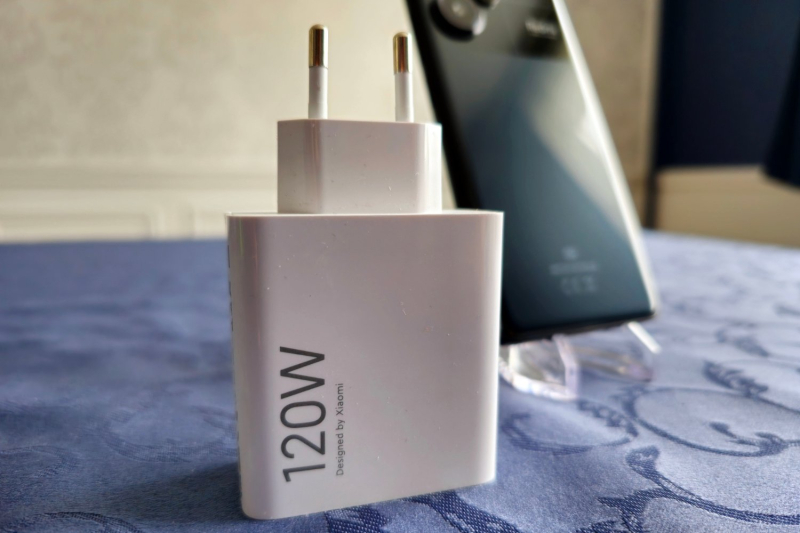
© Presse-citron
Indeed, its 120W fast charging allows to go from 0 to 100% in just under 20 minutes, which is an absolute luxury for airheads and the biggest strong point of this Redmi. Knowing that today's most high-end smartphones generally require 1h45 for an identical result, the mid-range here stands out spectacularly.
Given that chargers compatible with 120W charging remain relatively rare and expensive, giving this one automatically in the smartphone box is a very good initiative on the part of Xiaomi.
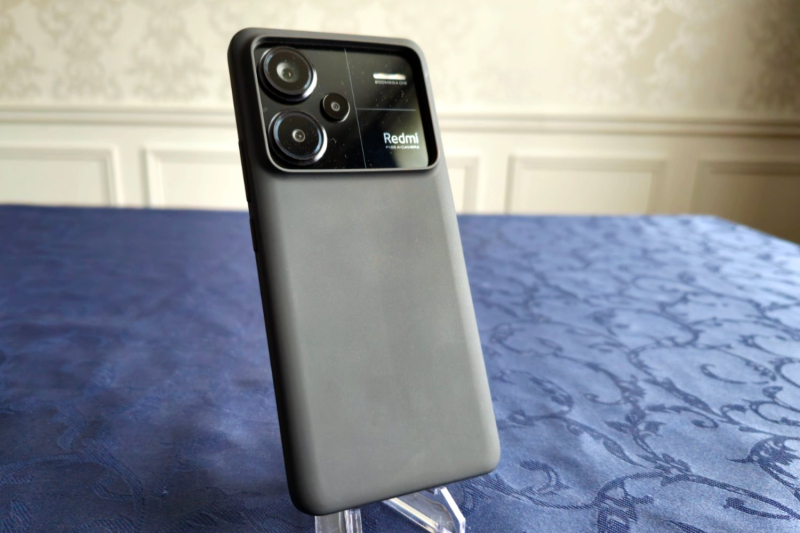
© Presse-citron
As for the autonomy of the smartphone, the Redmi Note 13 Pro Plus has a 5000 mAh battery. During our tests, we used the smartphone over several typical days (mixed use of 5G and Wi-Fi, 2 hours of videos, 3 hours of internet browsing, 2 hours of listening to music via Bluetooth, sending of RCS), and this one always lasted at least a day and a half.
Knowing that charging does not take more than 20 minutes, managing its autonomy gives even more peace of mind.
A slightly limited photo aspect
With a 200MP main lens, Xiaomi promises a 4x zoom experience without loss of quality for its photos. The photos that can be taken in ideal lighting conditions are quite good, even if Xiaomi tends to exaggerate the contrast to make the whole thing more flattering , but relatively far from the natural colors of the environments.

© Presse-citron

© Presse-citron

© Presse-citron

© Presse-citron

© Presse-citron
As for photos in macro format, don't expect good results here if you take them regularly, the lens dedicated to this 2MP mode is as bad as it is useless .

© Presse-citron
If the photos remain acceptable, no comparison is possible with the Pixel 7a in the same price category. So, if you want a smartphone below 500 euros that takes the best possible photos, the Redmi Note 13 Pro Plus is not the smartphone you need, the latter preferring to emphasize other aspects such as fast charging.

© Presse-citron

© Presse-citron
The software part, still the weak point of the Redmi
Using the latest version of MIUI 14, Xiaomi's overlay is still not very intuitive. Let's hope that the arrival of HyperOS, Xiaomi's new software overlay, happens quickly, with the international version planned for the coming weeks.
We will particularly regret that, like the Redmi Note 13, the Chinese manufacturer still imposes around fifteen bloatware on its smartphone, a practice which clearly does not help bring your OS into modernity. Fortunately, Xiaomi is promising at least 3 major Android updates, which should bring us to Android 15, given that out of the box, the Redmi Note 13 Pro Plus uses Android 13.
Our opinion on the Xiaomi Redmi Note 13 Pro Plus
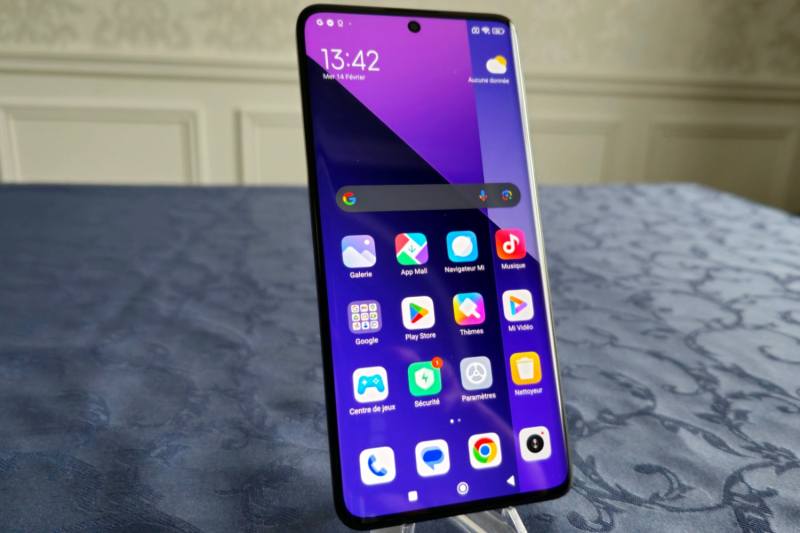
© Presse-citron
For some time now, Xiaomi has greatly improved the hardware design of its smartphones, and this Redmi Note 13 Pro Plus is further proof.
This elegant mid-range has a beautiful AMOLED screen and a pebble shape that is pleasant to hold. If we regret its software overlay which is still below what the competition can offer, we will particularly appreciate its autonomy and its 120W fast charging, which offers a total charge from 0 to 100 % in just 20 minutes.
If it is not the best smartphone in the category of less than 500 euros, it still remains a good alternative for those who want a rather complete smartphone.
📍 To not miss any news from Presse-citron, follow us on Google News and WhatsApp.

